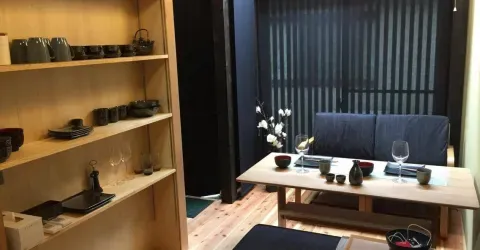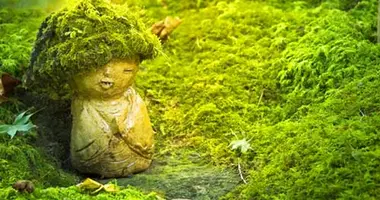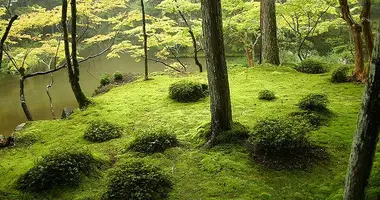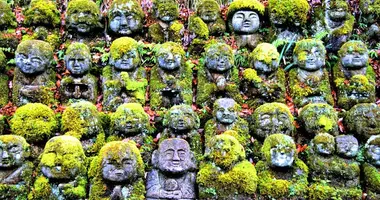Daikakuji Temple: A historic Buddhist sanctuary in Kyoto

Daikakuji Temple Shingyo Pagoda
Nestled in the western outskirts of Kyoto, Daikakuji Temple stands as a testament to Japan's rich imperial and religious history. Originally built as an imperial villa for Emperor Saga in the early 9th century, this magnificent complex later transformed into a significant Buddhist temple. With its stunning architecture, serene gardens, and cultural treasures, Daikakuji offers visitors a unique glimpse into the intertwining of imperial elegance and spiritual devotion. From its ancient moon-viewing traditions to its role in ikebana flower arrangement, Daikakuji continues to captivate visitors with its blend of historical significance and enduring beauty.
Origins and imperial connections
Daikakuji's story begins in the Heian period, when Emperor Saga (786-842) commissioned it as his detached palace called "Sento Gosho" around 1200 years ago. Located in the Sagano district of western Kyoto, this imperial retreat allowed the emperor to enjoy the area's natural beauty, including Mt. Arashiyama, bamboo groves, and seasonal cherry blossoms. The palace later became Emperor Saga's retirement residence, known as Saga Rikyu imperial villa.
In 876, approximately 30 years after Emperor Saga's death, his daughter Princess Masako converted the complex into a Buddhist temple, naming it Daikakuji. The temple's imperial connections remained strong, as it became a monzeki temple, meaning that only imperial princes were appointed as its abbots. This tradition continued until the early Meiji era (1868-1912), cementing Daikakuji's status as both a religious institution and an extension of the imperial family.
Architecture and layout of Daikakuji
Daikakuji's architecture reflects its dual nature as both an imperial residence and a Buddhist temple. The temple complex is composed of several buildings connected by elevated wooden walkways, reminiscent of its palace origins. Many of the current structures date from the 16th century onwards, as the original buildings were lost to time and fire.
The main building, known as the Shinden, was moved here from the Imperial Palace in the 16th century. In front of the Shinden lies an imperial-style garden featuring ancient orange and plum trees. Another notable structure is the Shoshinden hall, which houses several ink paintings from the renowned Kano school of artists, dating from the 15th to 18th centuries.
One of the most striking features is the vermilion Shingyoden pagoda, located north of the lake. This octagonal structure houses the Heart Sutra handwritten by Emperor Saga, which is displayed to the public only once every 60 years. The temple's layout, with its covered corridors and "nightingale floors" that squeak when walked upon, adds to the authentic atmosphere of an imperial residence turned Buddhist sanctuary.
The Osawa Pond and its significance
Osawa Pond, also known as Osawa-no-ike, is a central feature of Daikakuji and holds great historical and cultural significance. Created by Emperor Saga either during his reign (809-823) or shortly after, it is considered the oldest surviving artificial pond in Japan. The pond was designed to reflect the outline of Dongting Lake in China, showcasing the cultural exchange between Japan and China during this period.
Spanning 2.4 hectares, Osawa Pond exemplifies the chisen-shuyu style of garden design, meant to be viewed from a boat. It features two islands, with the smaller one known as Chrysanthemum Island (Kikugashima). The pond has been celebrated in poetry since the Heian period and remains a popular spot for moon-viewing and cherry blossom appreciation.
Today, visitors can enjoy the tranquil beauty of Osawa Pond throughout the year. During special events, such as the annual moon-viewing festival in autumn, traditional boats are brought out for visitors to experience the garden as it was intended centuries ago. The pond and its surrounding parkland offer a perfect setting for a stroll or a peaceful picnic, allowing visitors to immerse themselves in the same natural beauty that once captivated Emperor Saga.

Daikakuji Temple Lake aka Osawa Pond, western Kyoto
Cultural treasures and religious practices
Daikakuji houses a wealth of cultural treasures that reflect its imperial past and religious significance. The temple's main objects of worship are the Five Wisdom Kings (Godai Myō'ō), with a particular focus on Fudō Myō'ō, the Immovable Wisdom King. These statues, along with other important Buddhist artifacts, are displayed in the temple's main hall, the Godai-dō.
One of the most revered treasures is the handwritten copy of the Heart Sutra by Emperor Saga. According to legend, this sutra was written at the suggestion of Kukai, the founder of Shingon Buddhism, to end a deadly epidemic. This precious document is kept in the Shingyoden hall and is only displayed to the public once every 60 years.
Daikakuji is also known for its practice of shakyo, or sutra copying. This meditative practice, believed to bring merit and enlightenment, was introduced to the temple by Kukai. Visitors can participate in guided shakyo sessions held three times a month or engage in self-guided sutra copying any day.
Seasonal events and attractions
Daikakuji Temple offers a range of seasonal events and attractions that showcase its natural beauty and cultural significance throughout the year. One of the most popular events is the annual moon-viewing party (Kangetsu no Yūbe) held in September. For three nights around the harvest moon, visitors can experience a recreation of the Imperial moon-viewing parties of old, complete with costumed dancers, musicians, and dragon boats on Osawa Pond.
Spring brings the splendor of cherry blossoms, making Daikakuji a popular cherry-blossom viewing spot in Kyoto. The temple grounds are transformed into a sea of pink, offering breathtaking views around Osawa Pond. In autumn, the changing leaves create a stunning tapestry of colors, attracting visitors from far and wide.
Throughout the year, Daikakuji hosts various cultural events and exhibitions. These include displays of temple treasures in the Reihokan (Treasure House), which is open to the public in spring and autumn. The temple also serves as a venue for traditional performances and contemporary events, continuing Emperor Saga's legacy of cultural patronage.

The Saga Goryu school of ikebana
Daikakuji Temple holds a special place in the history and practice of ikebana, the Japanese art of flower arrangement. The temple serves as the headquarters for the Saga Goryu school of ikebana, one of the oldest and most prestigious schools of this traditional art form.
The origins of Saga Goryu are closely tied to Emperor Saga himself. According to tradition, the emperor once arranged chrysanthemums blooming on Kikuga-jima Island in Osawa Pond to present to the court. This act is considered the foundation of the Saga Goryu style, which emphasizes natural beauty and simplicity.
Today, the Saga Goryu school continues to preserve and develop its unique style of ikebana. The school's philosophy aims to be traditional yet vital, introducing visual and spiritual pleasure into daily life. Visitors to Daikakuji can often see beautiful ikebana displays throughout the temple, especially during special events and festivals. The temple also hosts an annual flower festival in spring, showcasing the artistry of Saga Goryu arrangements.

View of the lake, Daikakuji Temple
Visiting Daikakuji: practical information
For those planning a visit to Daikakuji Temple, here's some essential practical information:
- Location: 4 Saga Osawa-cho, Ukyo-ku, Kyoto 616-8411
- Access: 15-minute walk from JR Saga-Arashiyama Station, or 20 minutes from Arashiyama Station on the Keifuku Line
- Hours: 9:00 AM - 5:00 PM (last entry at 4:30 PM)
- Admission: Adults: 500 yen, Students (elementary to high school): 300 yen
- Notable features: Osawa Pond, Shingyoden pagoda, ikebana displays
Visitors are encouraged to explore the temple grounds, including the beautiful Osawa Pond and the various halls. Don't miss the opportunity to view the exquisite fusuma (sliding door) paintings and other art treasureson display. For a unique experience, consider participating in a shakyo (sutra copying) session or attending one of the seasonal events.
Daikakuji is located in the Arashiyama area, known for its scenic beauty and numerous attractions. Visitors might consider combining their trip to Daikakuji with other nearby sites such as the famous Arashiyama Bamboo Grove or Tenryu-ji Temple. Whether you're interested in Japanese history, Buddhist culture, or simply seeking a peaceful retreat, Daikakuji Temple offers a rich and rewarding experience for all who visit.





























